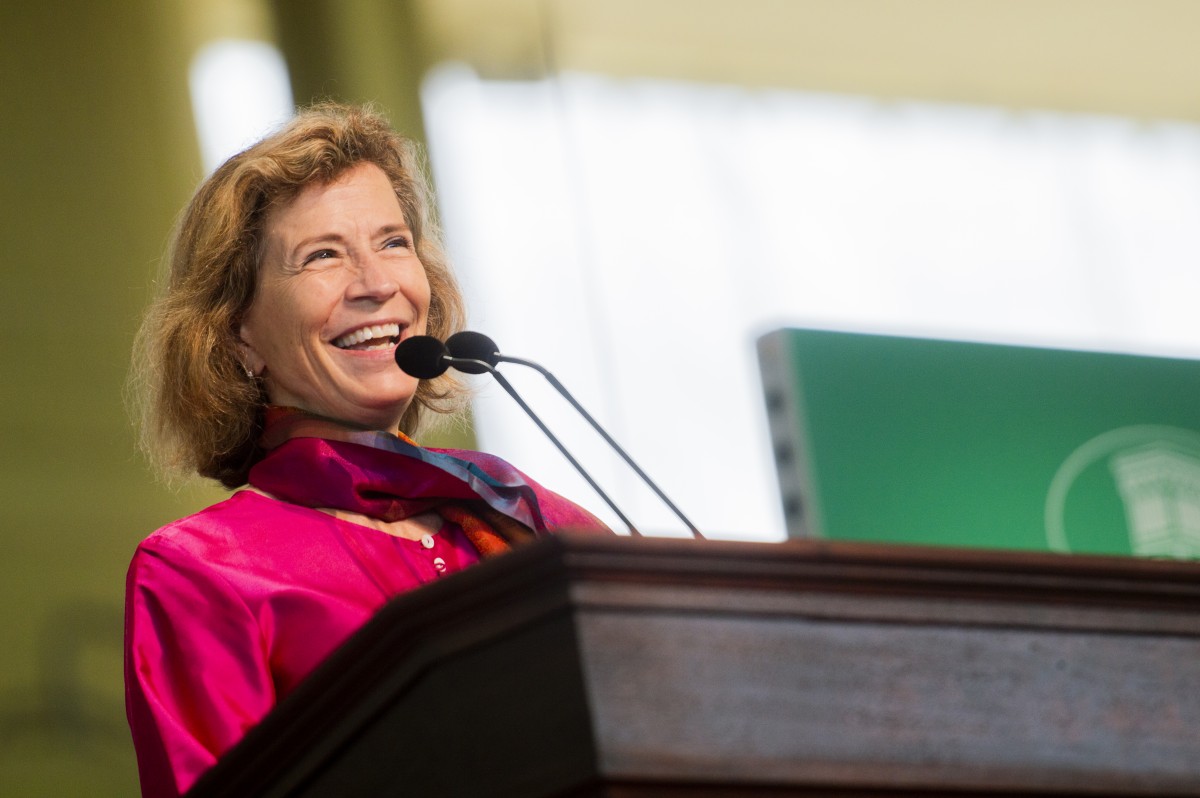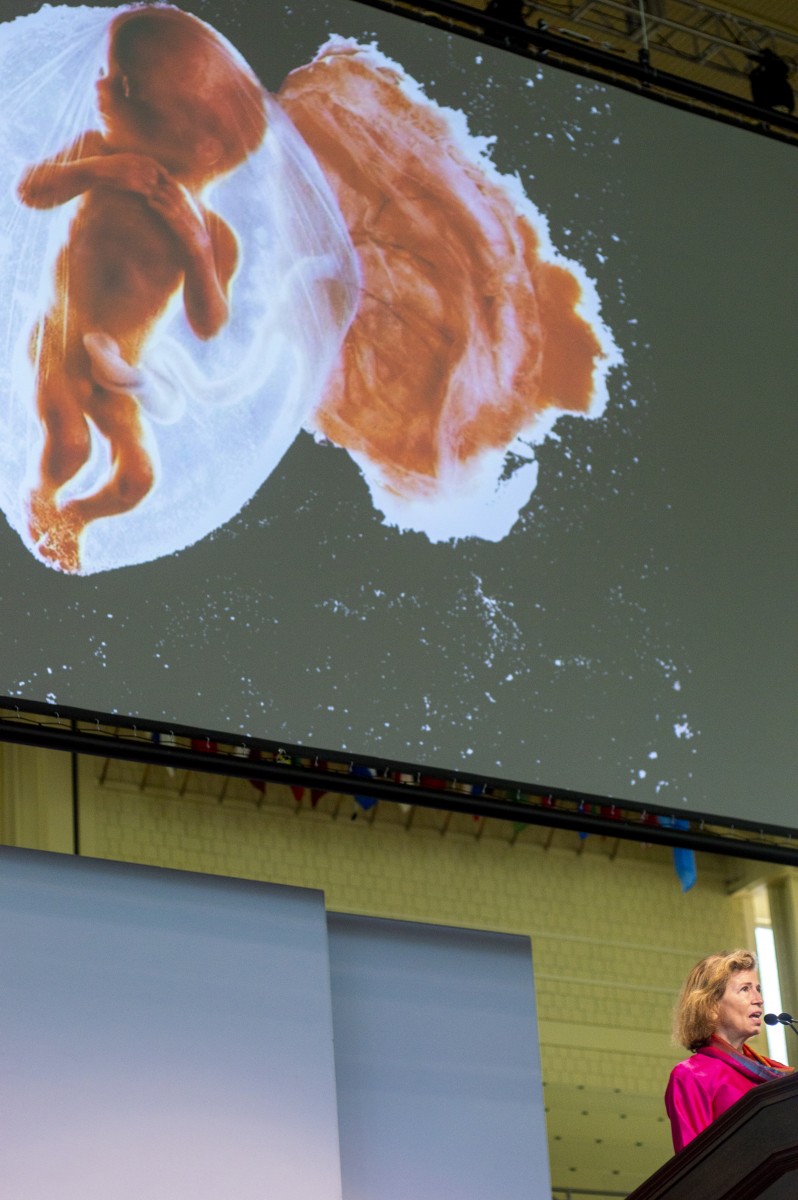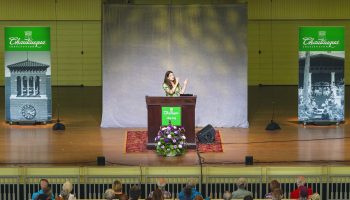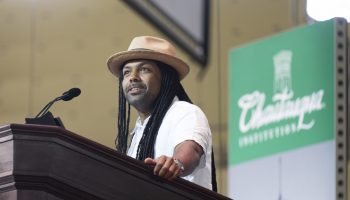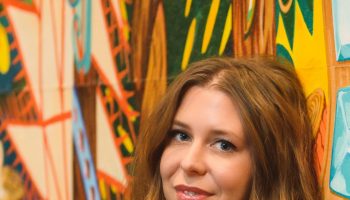Annie Griffiths likes to refer to herself as an “accidental photographer.”
The plan was always to be a writer, but two years into college, she realized it wasn’t the medium she wanted to use to tell her stories. That’s when she found photography. And if it’s true that a picture is worth a thousand words, she now has more in her collection than authors whose ranks she once aspired to join.
Griffiths, one of the first female photographers at National Geographic, spoke at the 10:45 a.m. morning lecture Monday, June 24 in the Amphitheater, opening Week One’s theme, “Moments That Changed the World.”
“What I did was: I tripped over a camera and fell completely in love with it and then threw my entire heart and soul into trying to catch up and become a strong enough photographer to be published,” Griffiths said.
“I needed to show to the women that follow me, and the men, that you can do this job without abandoning your family.” – @AnnieG_Photo
— The Chautauquan Daily (@chqdaily) June 24, 2019
Griffiths would spend her days lying behind her parents’ couch, a place she chose to read and learn, uninterrupted.
“I was laying on my belly with National Geographic and Life magazine and Look magazine and there were these indelible images that reflected moments in time,” she said. “I remember the exact images, I remember the feel of the paper and I remember being brought into worlds I really didn’t understand or know existed.”
Among the historical moments in the photos she continues to gather inspiration from, there was one she also experienced firsthand: 9/11. Griffiths lost three friends that day.
“So it was, for me, very personal and very tragic,” she said. “What I didn’t understand at that time is the ripple effect of these horrific things, the unintended ripple that then flows through the rest of the world and has powerful, sometimes disastrous and sometimes fabulous impact on the world.”
On the impact of 9/11- “the biggest byproduct is global fear… if you break hate down, you’ll find fear every time” –@AnnieG_Photo pic.twitter.com/aVfM7A7Z11
— The Chautauquan Daily (@chqdaily) June 24, 2019
But before Griffiths felt she could tell the audience that story, she needed to go back to the beginning of her own.
Her story begins with that of her mother, a midwestern, “good Catholic” girl whose life was shaped by the day she was born: May 20, 1927, the same day Charles Lindbergh, American aviator, began the first-ever solo flight across the Atlantic. Her mom was told that story her entire life and eventually, she too wanted a career in aviation.
“When she finished high school she went to the Pan Am office,” Griffiths said. “She went to see if she could get a flight attendant job and they wouldn’t even interview her. So, my mom, being the woman she was, said ‘Thank you very much’ and she packed her disappointment, left and became a pilot. This is what we can all do. We can be bitter or we can be determined.”
Griffiths took that message of perseverance with her throughout her own career, which started in her home state of Minnesota.
“Fortunately, my first stories were kind of in my own backyard,” she said. “So, I didn’t have to worry as much about language and disease and passports and visas and all of that stuff.”
Shortly enough, Griffiths fell in love with exploring her own country and culture. As much as she enjoyed working with wildlife and wide open spaces, it was always the people she met who made the greatest impact.
“The people are hardworking and solid and not the people who usually make the news, and that is important to me,” she said, “not just in our country, but everywhere I go. I don’t feel like I have been to a place unless I can get the heck out of the city and into the countryside to really experience the culture.”
When her career at National Geographic began, Griffiths started traveling internationally, something she never had the opportunity to do growing up. In that, she discovered what her purpose as a photographer was.
“I started traveling, and the job at Geographic really was to take you to all of the places that maybe you had never been, or take you to places you’ve been and show them in a new light,” Griffiths said.
Along the way, Griffiths had two kids: Lily and Charlie. Because her assignments lasted around three months a year, she decided she couldn’t leave them behind.
“So, I packed them up and I took them on my assignments,” she said. “I didn’t mention it at the office, but I figured they weren’t asking the guys about their day care situations. I recognized that I needed to show, for the women that might follow me, and the men, that you can do this job without abandoning your family.”
Griffiths made sure to only travel with her kids to locations that were guaranteed to be safe. These locations included Europe, New Zealand and to much of the audience’s surprise, the Middle East.
“(The Middle East) was so safe,” she said. “I mean that from my heart. Because it was so safe, I could take my kids there and they would be safe. We lived in Aqaba, Galilee, we traveled up to Syria. These were beautiful, beautiful places that were safer than any American city.”
While in the Middle East, she was drawn to Arab women, specifically Bedouin women. The more she photographed them, the more she realized the similarities they shared could benefit them both.
“I recognized that because I was a woman, there were all of these underreported stories that I could have access to,” Griffiths said. “It was the most wonderful thing for me to realize, that so many people are underrepresented in the media or misrepresented, and the biggest misrepresentation is usually of women in the developing world.”
Then Griffiths had an epiphany: She wanted her stories and her photos to be more than beautiful. She wanted them to make a difference.
In order to work toward that goal, she started making herself available to aid organizations. She focused mostly on environmental work, capturing issues such as deforestation, the destruction of salt marshes and the melting ice in Antarctica.
“This conservation work helped me feel like I was at least part of moving issues forward,” she said.
The exposure to world issues she gained from traveling brought her back to the concept of unintended consequences she experienced with 9/11.
One day, Griffiths was photographing a mother and daughter in a refugee camp of 70,000 people. The head of the camp told her hardly any of them would ever make it out because of 9/11.
“It just broke my heart and I thought ‘Well, what am I doing?’ ” she said. “ ‘I should just give up, I should walk away. I can’t make a dent in this, this is just too hard, too awful.’ ”
Two years later she was in a refugee coordinator’s office when she saw her photo of the mother and daughter on the wall. The man she was meeting told her they were doing great, and that the woman and her husband now both had jobs.
“I thought, ‘We can’t ever give up,’ and I didn’t get her out of that refugee camp,” she said. “I take pictures. But, if my pictures can help people who can get her out of a refugee camp, then that’s what I want to spend the rest of my life doing.”
That moment is where her nonprofit, Ripple Effects Images, was born.
The seven areas Griffiths and her team try to tackle in their coverage are health, food, water, education, economic empowerment, energy and climate change. She has captured content of positive impact in all of those areas, but the examples she shared started with health.
“Women are also really smart, and if you teach them how to keep their kids healthy, they’ll do it,” she said.
Griffiths once traveled to an indigenous community in Vietnam where she said the women had little to no access to health information.
“They didn’t know about washing to keep their kids healthy, and once they learned, the incidents of infection dropped dramatically,” she said. “It’s not rocket science, it’s information.”
In terms of education, Griffiths said she’s never talked to a poor mother who didn’t want her kids to be educated more than anything else of monetary value.
“Mandatory education for all children is imperative for any country to lift itself out of poverty,” she said.
Griffiths showed a photo of the poorest woman she had ever met. It was a woman in Kolkata, India, who had lost seven children to malnutrition. When she got a $25 micro-loan, she started a food business on the side of the road. One day, an orphan walked up to her stand. The woman took her in.
According to Griffiths, the first thing the woman did when she saved enough money was buy her daughter a school uniform so she could attend classes. After Griffiths took her photo and listened to the woman’s story, the daughter asked for her pen and notebook and brought it over to her mother. To Griffiths’ delight, the woman’s daughter had taught her how to read and write.
“That’s the ripple effect,” Griffiths said. “That’s it. And women who haven’t had the luxury of going to school are smart as can be, and they can be taught.”
Griffiths said agriculture is one of the most important things for women to be knowledgeable about.
However, this field in particular is not something she sees women entering on their own.
“They are gathering together in co-ops,” Griffiths said. “The solution for women globally is groups, a safe place to gather and learn from each other.”
On an assignment, Griffiths met a group of women in an agriculture co-op. In this co-op, the farmer brings her crops in instead of taking them to a middle man, and the other women weigh, sort and test the product for quality. Then there is a “commodities broker,” who asks the market what the going rate is for specific items and lists hers for less.
“These women will never, ever go back to the middle man,” she said. “They just won’t.”
Griffiths closed her lecture with a story from a trip to Pakistan, one she said “brings me to my knees.”
Griffiths was in a small village in the desert, and the hosts brought out their best cots and blankets for the guests to sleep on. The women made them soup, and as it was getting dark, one of the women asked Griffiths if she would like music. Griffiths said yes, and out came a group of elderly men with homemade instruments who would play for them until they fell asleep.
“I promise you, they had never heard of National Geographic,” she said. “They didn’t know who the heck this crazy white lady was who landed in their village, but they did what my mother always taught me people do. She said, ‘People with the least, give the most.’ So how could I not spend the rest of my life giving back?”
She concludes with a quote her mother always told her, “The people with the least give the most” –@AnnieG_Photo
— The Chautauquan Daily (@chqdaily) June 24, 2019

